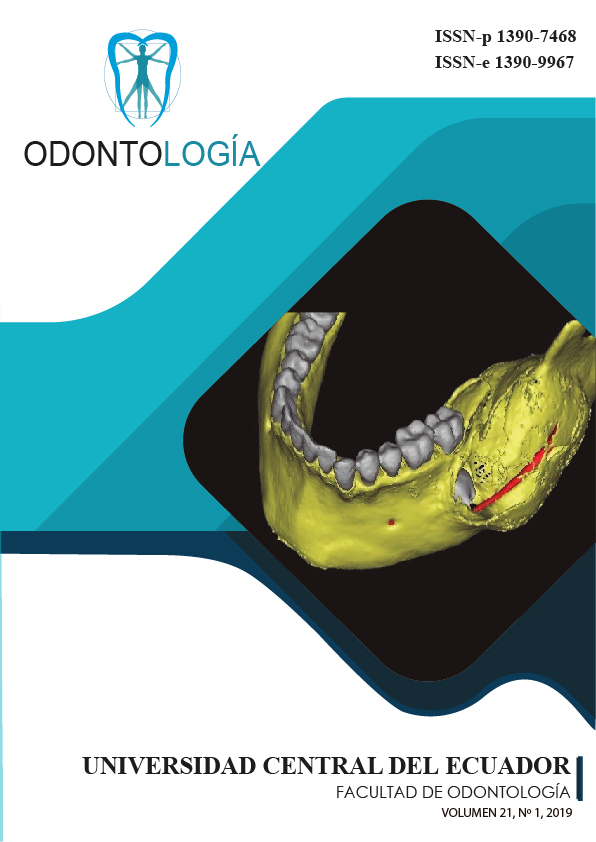Effectiveness of Lysol and Glutaraldehyde 2 % in high-speed handpieces after being subjected to mechanical cleaning
DOI:
https://doi.org/10.29166/odontologia.vol21.n1.2019-34-43Keywords:
Disinfection, Microbiology, Bacteria, PharmacokineticsAbstract
Chemical disinfection is an important procedure used in the dental field that aims to prevent the spread of pathogenic microorganisms that may affect health. Objective: To determine the disinfectant effectiveness of the Lysol and Glutaraldehyde 2% agent in aerosol in high-speed handpieces in ninth semester students who attend the Integral Clinic of the School of Dentistry of the Central University of Ecuador (FO-UCE) period 2017. Materials and methods: In vitro experimental study. The sample was obtained from 40 high-speed handpieces before and after subjecting the turbines to a disinfection process using two agents applied in aerosolized Lysol and Glutaraldehyde 2%. The samples were taken from two sites, head and handle. The samples were then transported to the FO-UCE Microbiology laboratory in tubes with thioglycolate, subsequently seeded in the blood agar medium and incubated for 48 hours at 37 ° to finally observe the formation of colony forming units. The statistical analyzes of ANOVA and Tukey with a significance level of 5% were used. Results: An effect on the bacterial reduction of 0.6 CFU glutaraldehyde and 1.3 CFU lysol was observed after use. Both glutaraldehyde and lysol showed significant differences before and after use (p <0.001), with no differences between the two after mechanical disinfection with both aerosol substances (p = 1.0). Conclusion: Glutaraldehyde and Lysol aerosol were effective in disinfecting high speed handpieces.
Downloads
References
Liébana J. Gonzáles M. Liébana M. Parra M, et al, editores. Composición y ecología de la microbiota oral. En: Microbiología oral. Vol 1. 2da edición. España. Mc Graw Hill. 1995. p. 515-525.
Romero B, Mendez N, Martínez M, Trejo Z, Villeda K, Tadeo Z. Comparacion bacteriana de 30 piezas de alta velocidad antes y después de ser utilizadas en la Facultad de Odontología Región Veracruz. Revista ADM. 2017; 74(4): 185-88.
Lima S. La importancia de la esterilización en piezas de mano. Informativo de Divulgación Dabi Atlante. 2003 junio;(1): p. 1-3.
Ortega S. Normas de Bioseguridad. En: Universidad Nacional del Nordeste Manual de Normas de Bioseguridad. Vol 1. 1ra edición. Argentina. 2013. p. 7-16.
Sánchez L, Sánchez E. Antisépticos y desinfectantes. Dermatología peruana. 2005; 15(2): p. 82-103.Lysol.com. EEUU, 200[actualizado 2017; citado Octubre 2017]
Disponible en: http://www.lysol.com/
Morales E. Estudio in vitro comparativo entre el savlon versus lysol para la desinfección de microorganismos retenidos en la superficie externa de la turbina en la clínica odontológica Uniandes. Tesis de Grado. Ambato: Universidad Regional Autónoma de los Andes, Facultad de Ciencias Médicas; 2014.
Vivero F. Análisis microbiológico del nivel de desinfección del glutaraldehído al 2% y sacarinato de alquildimetilbencilamonio al 95% en el instrumental crítico y semicrítico utilizado en la Clínica de Odontológica de la Universidad Internacional del Ecuador. Tesis de Grado. Quito: Universidad Internacional del Ecuador, Facultad de Ciencias Médicas, de la Salud y de la Vida; 2017.
Bhandary N, Desai A, Shetty YB. High speed handpieces. J Int Oral Health. 2014; 6(1):130-2.
Camacho A, Giles M, Ortegón A, Palao M, Serrano B, Velázquez O. Técnicas para el Análisis Microbiológico. México D.F:; 2009.
Pinto FM, Bruna CQ, Camargo TC, Marques M, Silva CB, Sasagawa SM, Mimica LM, Graziano KU. The practice of disinfection of high-speed handpieces with 70%w/v alcohol: An evaluation. Am J Infect Control. 2017; 45(1): e19-e22.
Evangelista Sde S, dos Santos SG, de Resende Stoianoff MA, de Oliveira AC. Analysis of microbial load on surgical instruments after clinical use and following manual and automated cleaning. Am J Infect Control. 2015; 43(5): 522-7.
Salazar P. Comparación de la efectividad de tres soluciones desinfectantes para las piezas de mano de alta velocidad en la clínica de odontopediatría de la Facultad de Odontología de la Universidad Central del Ecuador. Estudio in vitro. Tesis de Grado. Quito: Universidad Central del Ecuador, Facultad de Odontología; 2017
Reyes J, Rodriguez L, Fernandez M, Iparaguirre J, Montalvo W, Bravo K, et al. Análisis microbiológico antes y después de la utilización de la pieza de mano de uso odontológico. Kiru. 2012; 9(1): 13-20.
Gutiérrez C, Sonia J, Dussán D, Leal B, Silvia C, Sánchez A. Evaluación microbiológica de la desinfección en unidades odontológicas. Rev. Colomb. Cienc. Quím. Farm. 2008;37(2):133-49.
Singh M, Sharma R, Gupta PK, Rana JK, Sharma M, Taneja N. Comparative efficacy evaluation of disinfectants routinely used in hospital practice: India. Indian J Crit Care Med. 2012 Jul;16(3):123-9
Steinhauer K, Meyer S, Pfannebecker J, Teckemeyer K, Ockenfeld K, Weber K, Becker B. Antimicrobial efficacy and compatibility of solid copper alloys with chemical disinfectants. PLoS One. 2018; 13(8): e0200748.


